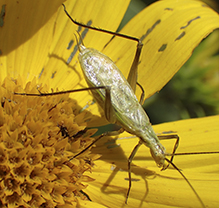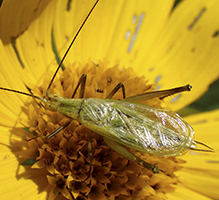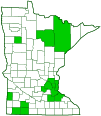Forbes’ tree cricket
(Oecanthus forbesi)
Conservation • Description • Habitat • Ecology • Distribution • Taxonomy
Conservation Status |
|
|||||||
| IUCN Red List | not listed |
|||||||
| NatureServe | NNR - Unranked |
|||||||
| Minnesota | not listed |
|||||||
Description |
||
Forbes’ tree cricket is a common singing insect. It occurs in the Upper Midwest of the United States, from Michigan, Ohio, and northern Kentucky in the east, to Minnesota, eastern Nebraska, and northern Missouri in the west. It also occurs in southern Ontario Canada. Though called a tree cricket, Forbes’ tree cricket is usually found on plants and shrubs within six feet of the ground. It is found on plant species too numerous to list, but it is especially abundant on goldenrods and sunflowers, and on tall weeds and bushes bordering lakes and ponds. It is sometimes found on low branches of small trees. It is not found high in trees. The genus name Oecanthus is Greek from “to inhabit” and “flower”. Adult Forbes’ tree crickets are active from August to November. They are omnivorous. They feed mostly on plant matter, including leaves, fruits, and flowers, but they also feed on smaller insects and other invertebrates, and on insect eggs. Adults are 7⁄16″ to 11⁄16″ (11.5 to 18 mm) in length, which is small for an orthopteran but medium-sized and robust for an Oecanthus. The head is usually pale greenish yellow. There is often a black longitudinal stripe on the top of the head and another on each side of the head. The stripes continue across the exoskeletal plate covering the thorax (pronotum). They are highly variable in both size and intensity. On some individuals, the head is entirely black, but the compound eyes are always yellowish. There are no small simple eyes (ocelli). The antennae are thread-like and very long, often two-and-a-half times as long as the body. There are 18 Oecanthus species in North America north of Mexico. They are very similar in appearance and are usually identified by the markings on the first and second antennal segments. This character is difficult to observe in the field, or even from most photographs, but it is very useful in determining the species. On Forbes’ tree cricket, the antennae are either entirely black or pale brown. On pale antennae, the first and second segments are pale green and there are two black marks on the underside of each. On the first segment, the inner mark is two times as long as the outer mark. The two marks are broad and are often joined together. On the second segment, the marks are oblong and parallel. The inner mark is longer than the outer mark. The body of the female is green. The body of the male is pale yellowish green. The pronotum is longer than wide. It is slightly narrower in the front than in the rear. The corners of the lower lobes are rounded. On the underside of the abdomen there is a pair of large black spots on each abdominal segment. On the female, the needle-like egg-laying tube at the end of the abdomen is straight. The leathery front wings (tegmina) on the male are translucent, flat, and rigid. They are much wider than the abdomen. The tips are broadly rounded. On the female, the tegmina are narrower and membranous. They are held tightly wrapped about the body. The hindwings are as long or slightly longer than the tegmina. The legs are very slender. They are either entirely black or are yellowish with a blackish tinge. The third segment (femur) of all legs is unarmed. The fourth segment (tibia) of the hind legs is armed with two rows of three to six long spines with numerous minute teeth between the spines. There are also three pairs of strong spines near the tip of the hind tibia. The last part of each leg (tarsus), corresponding to the foot, has three segments. The basal segment is longer than the other two combined. The tibia and tarsi are black. |
||
Size |
||
| Total length: 7⁄16″ to 11⁄16″ (11.5 to 18 mm) | ||
Song |
||
The song is a shrill, continuous trill, whi-r-r-r-r, repeated several times with varying lengths, the entire song lasting several minutes. The pulse rate and frequency of the song vary with temperature. At 65° F (20° C) there are about 51 pulses per second at 3.2 kHz. At 77° F (25° C) there are about 70 pulses per second at 3.9 kHz. |
||
Similar Species |
||
Black-horned tree cricket (Oecanthus nigricornis) is identical in appearance and cannot be distinguished from photographs. The male can be distinguished by noting both the number of pulses per second in its song, and the air temperature at the spot where it is singing. Oecanthus nigricornis females cannot be distinguished from Oecanthus forbesi females except geographically. Oecanthus nigricornis does not occur east of Ohio. |
||
Habitat |
||
|
||
Ecology |
||
Season |
||
One generation per year: August to November (adults) |
||
Behavior |
||
Males sing both day and night. |
||
Life Cycle |
||
Mating begins in August. Eggs are laid from September through November. The eggs overwinter and hatch in June the following year. The nymphs undergo paurometabolous development (gradual metamorphosis) and look like small adults. They take 13 months to mature into adults. |
||
Nymph Food |
||
Same as adults |
||
Adult Food |
||
Mostly plant leaves, fruits, and flowers, but also smaller insects and other invertebrates, and insect eggs, |
||
Distribution |
||||
|
Sources Walker TJ. 1963. The taxonomy and calling songs of United States tree crickets (Orthoptera: Gryllidae: Oecanthinae). II. The nigricornis group of the genus Oecanthus. Ann. Entomol. Soc. Am. 56: 772-789. The sightings in Anoka County are from Cedar Creek Ecosystem Science Reserve. Though listed as Oecanthus nigricornis, they are very likely misidentifications of Oecanthus forbesi. |
|||
| 11/24/2023 | ||||
Occurrence |
||||
Common |
||||
Taxonomy |
|||
Order |
Orthoptera (grasshoppers, crickets, and katydids) |
||
Suborder |
Ensifera (katydids, crickets, and allies) | ||
| Infraorder | Gryllidea (crickets) | ||
Superfamily |
Grylloidea (true crickets and allies) | ||
Family |
Oecanthidae (tree crickets and bush crickets) | ||
Subfamily |
Oecanthinae (tree crickets) | ||
| Supertribe | Oecanthidi | ||
Tribe |
Oecanthini | ||
Genus |
Oecanthus (common tree crickets) | ||
Synonyms |
|||
Oecanthus nigricornis quadripunctatus |
|||
Common Names |
|||
Forbes’ tree cricket Forbe’s tree cricket (misspelling) four-spotted tree cricket |
|||
Glossary
Femur
On insects and arachnids, the third, largest, most robust segment of the leg, coming immediately before the tibia. On humans, the thigh bone.
Membranous
Thin, pliable, and more or less transparent.
Ocellus
Simple eye; an eye with a single lens. Plural: ocelli.
Ovipositor
A tube-like organ near the end of the abdomen of many female insects, used to prepare a place for an egg and to place the egg.
Pronotum
The exoskeletal plate on the upper side of the first segment of the thorax of an insect.
Tarsus
On insects, the last two to five subdivisions of the leg, attached to the tibia; the foot. On spiders, the last segment of the leg. Plural: tarsi.
Tegmen
The modified, leathery front wing of grasshoppers and related insects that protects the hindwing. It may also serve as a camouflage, a defensive display, or a sound board. Plural: tegmina.
Tibia
The fourth segment of an insect leg, after the femur and before the tarsus (foot). The fifth segment of a spider leg or palp. Plural: tibiae.
Visitor Photos |
|||||
Share your photo of this insect. |
|||||
| This button not working for you? Simply email us at info@MinnesotaSeasons.com. Attach one or more photos and, if you like, a caption. |
|||||
Babette Kis |
|||||
Oecanthus forbesi Forbes tree cricket Oecanthus forbesi, Forbes tree cricket, Chiwaukee Prairie, Kenosha Co., Wisconsin. Photo was taken on Sept. 4, 2021. |
 |
||||
 |
|||||
MinnesotaSeasons.com Photos |
|||||
|
|||||

Slideshows |
||

Visitor Videos |
|||
Share your video of this insect. |
|||
| This button not working for you? Simply email us at info@MinnesotaSeasons.com. Attach a video, a YouTube link, or a cloud storage link. |
|||
Other Videos |
|||
| FORBE'S TREE CRICKET, Oecanthus forbesi nymph ob Curtis |
|||
About
Nov 8, 2019 FORBE'S TREE CRICKET, Oecanthus forbesi nymph. Horner Park, Chicago. 8/22/2019 |
|||
| Forbes' Tree Cricket, Oecanthus forbesi, singing MJBugs |
|||
About
Dec 4, 2013 Forbes' Tree Cricket, Oecanthus forbesi. singing in a planted prairie. September 3, 2013 Many thanks to the 3 experts who determined the songster: |
|||


Created: 11/25/2023
Last Updated:

